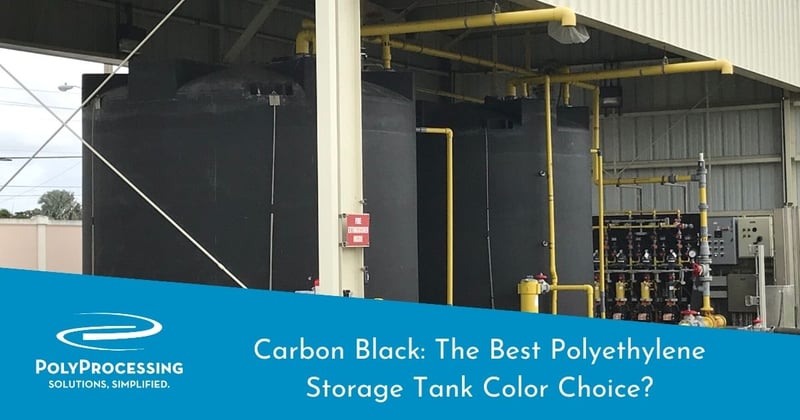Carbon Black: The Best Polyethylene Storage Tank Color Choice?
A wide variety of colors are available for polyethylene storage tanks. Cosmetics to match the surrounding buildings and landscape, customer preferences, and the application or the chemicals being stored are factors determining tank color selection. However, one color which is almost always selected for higher end storage solutions, such as storing harsh, aggressive chemicals such as sodium hypochlorite, is black.

Let’s explore why black, or more specifically, carbon black, is a smart color choice.
What Is Carbon Black?
Carbon Black is a form of nearly pure, elemental carbon. With its different molecular structure from other forms of elemental carbon, graphite and diamond, carbon black has different physical properties. It’s softer than graphite and diamond, and intensely black in color. Carbon black is manufactured by burning hydrocarbon fuels in a reduced heat, controlled manner. Kerosene is the most common hydrocarbon used in manufacturing carbon black.
.jpg?width=297&name=Industrial%20Water%20Treatment%20Tank%201%20(7).jpg)
Why Carbon Black?
Carbon black has many applications in plastics. It’s used as a pigment, conductive filler material, particulate reinforcement, and UV absorber. In polyethylene or plastic chemical storage tanks, carbon black is used as both a pigment and UV absorber. Carbon black is the standard for UV absorption, when compared to opaque white storage tanks that are pigmented with Titanium Dioxide.
Carbon black offers superior weather resistance in storage tanks housed outside. Polyethylene tanks in addition to heating when exposed to sunlight, also degrade from exposure to Ultraviolet rays. UV turns plastic brittle through photodegradation. This degradation results in loss of mechanical properties, discoloration, cracking, fading, and chalking. Photodegradation weathers polyethylene.
A simple, inexpensive method to protect polyethylene from UV degradation is adding carbon black as an internal stabilizer material. Carbon black, added as a stabilizer, absorbs or screens out damaging UV rays. The rays are transformed into heat. The heat is harmlessly dissipated throughout the tank itself.
The UV index value or rating of carbon black according to an independent study conducted over a 36 month period in the Arizona desert, supports carbon black as a superior UV resistant material.
While black chemical tanks have a slightly higher overall temperature than light or white tanks, the UV protection the carbon black provides outweighs the effects of slightly elevated temperature levels. The life of the tank is extended and catastrophic failure reduced due to the potential breakdown of the polyethylene. As a result, carbon black, is the preferred pigment for storing harsh chemicals such as sodium hypochlorite. Download our Carbon Black white paper here.
Using carbon black in high density crosslinked polyethylene tanks gives you the best of both worlds. Cross-linking is simply the formation of bonds between the polymer chains. These bonds, equal in strength and stability to the principal bonds along the polymer backbone, tie the polymers together, thus dramatically increasing molecular weight. In fact, the length of the polymer chains and, therefore, the physical properties, are much better than can ever be achieved without crosslinking.
The result of the is a plastic that possesses impact resistance, tensile strength, and resistance to fracture that linear polyethylene just can’t match. These qualities make cross-linked polyethylene an excellent choice when tank integrity is critical. The structural integrity, heat resistance, and useful life in most cases are unparalleled.
For more information or questions regarding chemical storage tank color selection, please contact a Poly Processing storage tank specialist.
- March 13, 2023
- Topics: Fittings and Accessories
About Poly Processing
Posts By Topic
Tech Talk Podcast Episodes
Subscribe By Email
Recent Posts
- Installation Tips for Chemical Storage Tanks: Site Preparation and Offloading
- Understanding pH and Chemical Concentration When Choosing a Chemical Tank
- Maximizing Fill Efficiency: Selecting the Optimal Fill Line System
- Chemical Storage Tanks: A Quick Guide for End Users
- Popular Customization Options for Chemical Storage Tanks
Tank Configurator

Find the recommended tank and system components for your chemical storage challenge.
Configure a Tank Package




